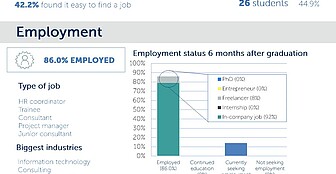
This website uses functional cookies, including analytical cookies. The obtained statistical data cannot be traced back to individual users. Additionally, you can choose to accept or refuse consent to use marketing cookies. If you decline these additional cookies or refrain from making a choice, only functional cookies will be set. See our cookie policy for more information.
Article: Thursday, 19 June 2014
As interest in the servant leadership model has grown among academics and managers alike, so too has curiosity about the complex mechanisms underpinning it and its applicability within real-life relational and organisational circumstances. These and other concerns are explored in a recently published research paper, which adds considerably to our understanding of this leadership approach.

This video cannot be loaded, as you have not accepted cookies.
Click here
to watch this video directly at the source.
Managers are expected to lead by example and team members look to their manager for advice, support, direction and leadership. However, where do they draw the line between advancing their own position and managing their team and its performance? What if they actually viewed themselves in a much humbler role, serving their team first and foremost, before considering opportunities such as self-promotion and corporate ladder climbing? Such is the underlying trait of a servant leader.
The springboard for studying this original and fascinating view on leadership is a question that faces the vast majority of managers – how do I help my team members get the most out of their work? Do I really want to lead a group of people who are there just to pick up the salary or is there a way I can help them find meaning to their job, for the common good of the team and company?
Trust is one of the foundations upon which managers can approach this question – trust in their team members but also in their own ability to adopt a less conventional managerial role. The servant leader empowers team members and builds confidence by displaying humility, authenticity, and the courage of his or her convictions whilst also being able to take a step back, motivate people to perform and offer support and praise when it is deserved. In short, the team and team performance come first, whilst self-gain comes later.
The servant leader empowers team members and builds confidence by displaying humility
The servant leader is not averse to seeking power and appraisal but the priorities and the process are different – the aspiration for power emerges from an initial need to serve. For the servant leader, the latter precedes the former. If there is no cause to serve, the servant leader does not aspire for power. Therein lies the fundamental difference with other leadership approaches.
“Development” and “growth” are buzzwords for servant leaders – they want to build on the potential of individuals for the common good by giving those people a chance to show their worth to the company. This particular managerial approach also facilitates the creation of a more ethical decision-making process, positions team members not as a means to an end but as an actual focus of leadership and potentially creates more organisational adaptability and flexibility within the team.
In theory, servant leadership makes great sense as an important driver of business performance, but does it really hold out there in the business world? Some studies seem to indicate that it does. However, little is still known about how it affects the leader-follower relationship and whether it stands under very adverse situations (eg, during a merger) or in fluid self-managed teams, to name two extreme examples. Our studies helped shed some more light on these topics.
The various characteristics of the servant leader, as suggested by Dirk van Dierendonck, Associate Professor of Organisational Behaviour at Rotterdam School of Management, Erasmus University, were initially tested through simulation exercises performed with undergraduate students in self-managed teams. This enabled us to verify that teams perform well when members show servant leadership behaviours towards one another, even in the absence of a formal team leader. At the same time, we were able to identify four core attributes of servant leadership. Of the original eight main qualities of the servant leader, our studies home in on four as having the greatest impact on the leader-follower relationship and its potentially positive contribution to the team – empowerment, humility, accountability, and stewardship.
To further verify the effectiveness of servant leadership in a business context, a potentially “extreme” situation was analysed – that of two large firms in the midst of a merger process, with all the associated stresses such an operation usually generates. Here we observed that servant leaders were able to keep people engaged despite the highly uncertain transition, right in the eye of the hurricane. They achieved this both by granting a sense of psychological empowerment and ensuring a stronger identification with the newly formed merged organisation.
Ancient and classic thinkers like Lao-Tzu, Kant or Saint-Augustine, just to name a few, praised the notion of humility. This is a fundamental cornerstone for the whole servant leadership concept. But how does humility impact performance? We were able to confirm that a humble attitude works in tandem with the leader’s ability to instil directed action, in fact amplifying the leader’s effectiveness. In other words, if a leader is competent while being humble, people will feel more engaged and motivated to follow.
So, what could be viewed from one perspective as the leader actually under-estimating him or herself actually seems to be a powerful potion as a way of psychologically empowering teams members and “bringing them to life” for the good of the team and company. People no longer feel shackled by the constraints of a top-down hierarchical approach to management and have more room to explore and be themselves.
The more collectivist and follower-focused approach implied by servant leadership provides fertile territory for continued research, but how far could this model be applied? Servant leadership seems to work in different contexts but there remains a delicate balance between acting with humility and ensuring performance levels are maintained, if not raised. How this potential “juggling act” would be managed from one country to another is also open to huge debate, as well as how it could be successfully achieved within a multi-cultural set-up.
In addition, our tests and findings raise many questions about the notion of power in explaining leadership effectiveness. Understanding servant leadership in light of traditional power bases like coercion, legitimacy, reward, expertise, reference and information would be important. Servant leadership might be just the right approach for organisations in an age, as advanced recently by researcher Moisés Naim, of decaying power.
The greater the ability of the 'servant leader' to balance humility with action, the higher the chances of effective team performance and results.
Of the many findings one or two are worthy of extra attention, in terms of their practical implications for managers and HR professionals. “Ownership” is a term not used so far but ultimately the combined effect of the many positive qualities of the servant leader is to make team members feel more involved and therefore “in charge” of their work. Nevertheless, this comes with a certain pressure – accountability is not just about being rewarded, especially if one fails to meet targets.
The notion of leadership can also be viewed in a very different light – if the servant leadership model were to be successfully implemented within companies, then leadership is no longer based on a hierarchical structure designed to keep people in their place but rather a process of driving forward collectively, as a team.
It is also important that practitioners get to grips with the potential cultural fall-out of the servant leadership issue. As a Portuguese national working in the Netherlands, I can already speak for two very different approaches, and that’s even before we start to explore differences from continent to continent.
One thing is for certain – the greater the ability of the “servant leader” to balance humility with action, the higher the chances of effective team performance and results.
NOVA School of Business and Economics (NOVA SBE)

Milton Sousa is Associate Professor Adjunct and Academic Director of the CEMS MIM at NOVA School of Business and Economics. Previously, he was Director of the MBA Programs at the Rotterdam School of Management, Erasmus University in the Netherlands.
This article draws inspiration from the Ph.D. thesis "Servant Leadership to the Test - New Perspectives and Insights", written by Milton Sousa.

In support of the growing adoption of servant leadership and empirical evidence of its effectiveness, this dissertation expands on the applicability of servant leadership in different organizational and relational contexts. Two of a total of four empirical studies were focused on contrasting organizational perspectives. The first study allowed developing a new short measure of servant leadership which can be particularly suited for shared leadership assessments. Through this instrument it was possible to observe that shared servant leadership in small self-managed teams positively affected team behavioral integration and performance. A second study showed that servant leaders can be effective in ensuring workforce engagement during significant and uncertain large scale change processes through increased organizational identification and psychological empowerment. The two other studies of this dissertation emphasized relational factors. The third study allowed for a better understanding of the interaction between the virtuous and the action side of the servant leader. In particular, the virtuous side, which rests on an attitude of humility and standing-back, amplifies the impact of the action side on follower engagement, but this effect is only evident when the leader is in a high position of power. The fourth and last study focused on differences between self and other perceptions of leadership and had as main conclusion that servant leaders seem to under-estimate their own leadership behavior, confirming their humble nature. Finally, this dissertation provides also additional evidence on the potential validity of servant leadership across different national cultures.



















Science Communication and Media Officer
Rotterdam School of Management, Erasmus University (RSM) is one of Europe’s top-ranked business schools. RSM provides ground-breaking research and education furthering excellence in all aspects of management and is based in the international port city of Rotterdam – a vital nexus of business, logistics and trade. RSM’s primary focus is on developing business leaders with international careers who can become a force for positive change by carrying their innovative mindset into a sustainable future. Our first-class range of bachelor, master, MBA, PhD and executive programmes encourage them to become to become critical, creative, caring and collaborative thinkers and doers.
